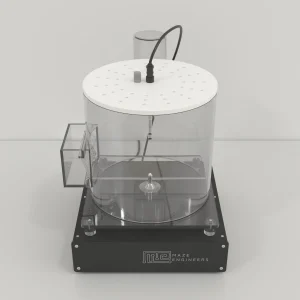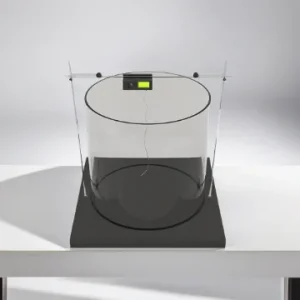$5,900.00 – $6,490.00Price range: $5,900.00 through $6,490.00
The Orofacial Pain Assessment Device (OPAD), developed by Neubert et al. (2005), is an operant pain assessment system that depends on voluntary behavior. Using the OPAD allows for a focused evaluation of pain, going beyond simple reflex actions and innate responses. This approach incorporates executive functioning and various experiences, making a conflict-based paradigm a more sensitive tool for comprehensive pain analysis.
The OPAD comprises a thermode and metal wires to evaluate both thermal and mechanical sensitivity. In this setup, a food-deprived subject is placed in an operant chamber, where it can only access a food reward by interacting with the thermal and mechanical stimuli. This design encourages the subject to tolerate discomfort in order to receive the reward. Unlike traditional methods that primarily measure reflexive responses, the OPAD empowers subjects to determine their own stimulus threshold to earn rewards. This conflict-reward model enhances face, content, and predictive validity, and it also captures the psychological and affective aspects of pain similar to those experienced by humans.
Other similar devices include the Electric von Frey Filament and the Tail Flick Test

MazeEngineers empowers preclinical neuroscience research with meticulously designed, customizable behavioral apparatuses. From manual classic mazes to fully automated smart systems, we provide the tools scientists need to capture high-quality, reproducible data for studies on learning, memory, anxiety, and depression.



Mouse |
Clear Acrylic Chamber with a metal base |
Chamber Dimensions: 10 x 10 x 20 cm (L x W x H) |
Dual Peltier-controlled temperature thermodes or mechanical protrusions |
Feces and urine tray; removable for feces and urine removal |
One Maze Engineers’ reward bottle having a metal spout and lick detection |
Software included |
Rat |
Clear Acrylic Chamber with a metal base |
Chamber Dimensions: 20 x 20 x 20 cm (L x W x H) |
Dual Peltier-controlled temperature thermodes or mechanical protrusions |
Feces and urine tray; removable for feces and urine removal |
One Maze Engineers’ reward bottle having a metal spout and lick detection |
Software included |
Manual start / stop white noise as ambient noise

Take advantage of Neuralynx, Ethovision Integration, SMS and Email integration with the Conductor Science Software. No I/O Boxes Required

2.1 Origin
Most pain assays used in preclinical research rely on simple reflexes or innate behaviors to measure pain. These methods, though simple and objective, do not take into consideration other factors associated with pain behavior. Neubert et al. (2005) aimed to develop a system that would allow a better assessment of pain and associated behaviors. The Orofacial Pain Assessment Device was designed to provide the subject with a conflict to either experience the pain to gain a reward or to avoid the aversive stimuli and gain no reward. This system enabled the observation of behaviors that involved different levels of the nervous system. Thus, the OPAD assay improves the translatability of the observation for human applications.
Neubert et al. (2006) investigation revealed that at temperatures 42° C and 45° C significant allodynic and hyperalgesic effects induced by capsaicin could be observed. Another study by Rossi et al. (2006) employed the OPAD to investigate the cold sensitivity of male and female rats. When subjects were evaluated at above-freezing temperatures of 24° C, 10° C, and 2°C, the difference in behavioral performances of males and females could be observed. However, statistical significance was reached only at 10° C temperature. Males were observed to lick less often and consume less milk in comparison to the females.
Since the OPAD relies on affective responses, Rossi and Neubert (2008) used it to evaluate the effects of environmental enrichment on thermal sensitivity. When 7-week-old male hairless Sprague-Dawley rats were maintained in an enriched environment that included objects like cardboard boxes, hammocks, exercise wheels, and other enrichments, an effect on thermal sensitivity could be seen. In comparison to standard cage-maintained rats, enriched rats showed better performance in the OPAD at temperatures 2° C, 24° C, and 45°C. However, though an enriched environment can potentially improve tolerance, the effects do not occur at strongly aversive or pain threshold temperatures.
2.2 Developments
The initial design of the OPAD only employed thermal stimulations. Nolan et al. (2011), further adapted the OPAD to include nickel-titanium wires to act as mechanical stimuli. The cables also conducted electricity, thereby, allowing the experimenters to detect and record actual facial contacts. This addition of a removable mechanical stimulation allowed experimenters to evaluate the pain response to different combinations of stimuli.
Pain alleviation in humans is influenced by transient receptor potential (TRP) cation channels involved in the perception of hot and cold pain. TRPV1 and TRPM8/TRPA1 were altered by capsaicin and menthol administration by Anderson et al. (2014) to investigate the effects of these channels on nociceptive behaviors. OPAD performance observations showed that the co-activation of TRPM8/TRPA1 and TRPV1 made cool temperatures less nociceptive.
2.3 Recent Developments
Nag and Mokha (2016) tested the performances of male and ovariectomized (OVX) Sprague-Dawley rats in the OPAD. The investigation aimed to understand the effects of the activation of the trigeminal α2-adrenoceptor on nociception and hyperalgesia. The investigation was able to highlight the sex-dependent antinociception and antihyperalgesic effects of α2-adrenoceptor. Further, the effects of hormones on the control of pain were also shown suggesting the need for sex-specific therapeutic treatments.
The effect of diets on the reduction of pain was evaluated by Bowden et al. (2017). The study involved the assessment of cocoa flavanols on orofacial pain of male and female Sprague-Dawley rats. It was observed that the subjects that were maintained on cocoa-enriched diets had better pain thresholds when evaluated in the OPAD. The observations led to the suggestion that diet modifications can be potentially used for the management of pain.
The temperature can be finely tuned within a range of 4° to 75°C, and various experimental parameters can be easily managed through the accompanying software and an LCD display. The apparatus also includes a reward bottle with a metal spout, allowing access to the reward only when the subject simultaneously interacts with the thermode or mechanical protrusions. Additionally, the device is capable of automated data recording for seamless analysis.
Clean the Orofacial Pain Assessment Device thoroughly before and after every use and between subjects. Appropriately illuminate the arena. Ensure that the presence of unnecessary external stimuli is minimized. In addition to the OPAD system’s data acquisition, tracking, and video system can also be used.
Operant procedures are most effective with hairless rodents. If the rodents have facial hair, it is advisable to use suitable methods for its removal. Be sure to remove only the buccal hair, avoiding the vibrissae pad/whiskers to prevent any impact on the subject’s behavior. Perform the hair removal procedure one to two days prior to testing to ensure accurate results, and apply any treatments before the testing begins.
Fill the reward bottle with the designated liquid and position it on the stand so that the subject must contact the thermodes with its buccal region to access the spout. Once the subject is placed in the chamber, adjust the reward bottle’s position if the subject’s vibrissae touch it or if the buccal region fails to make contact with the thermodes. Set the thermodes to the appropriate temperature and initiate the trial for the predetermined duration. Continue repeating the trials as necessary.
The original Operant Pain Assessment Device was specifically designed to evaluate thermal sensitivity. It featured a pair of thermodes made from grounded aluminum tubing, which framed the opening to the reward feeder. Thermal stimuli were created by circulating water, either heated or cooled, through flexible polyethylene tubing to reach the desired temperature.
Subsequently, the OPAD was enhanced to incorporate a mechanical component. Two rows of nickel-titanium wires were introduced at the reward opening to evaluate mechanical allodynia, hyperalgesia, and pain in the orofacial region. Experiments were conducted to examine how varying wire diameters affected performance. It was found that thicker wires significantly reduced the licking/facial contact ratio compared to thinner ones. Further studies on wire thickness, especially after applying capsaicin and pain treatments, revealed different results.
Rohrs et al. (2015) made additional modifications to the mechanical aspect of the OPAD by implementing a 360-degree arrangement of looped stainless steel wires. This design aimed to enhance the assessment of mechanical sensitivity while reducing avoidance behavior in the subjects.
The Orofacial Pain Assessment Device employs a reward-conflict paradigm to measure pain behavior effectively. This straightforward device enables the evaluation of pain parameters through responses to both thermal and mechanical stimuli, facilitating comparisons of pain responses within a unified system. It allows for performance assessments between treated and untreated groups, as well as comparisons among various disease and lesion groups.
The following measures can be obtained in the OPAD:
The Operant Orofacial Assessment Devices facilitate the evaluation of both mechanical and thermal pain sensitivity within a unified framework. This setup enables direct comparisons of performance across both modalities while maintaining consistent experimental parameters. Unlike conventional pain assays, the OPAD depends on the voluntary actions of the subject, minimizing stress since no restraint is needed. Additionally, its investigator-independent design allows for unbiased analysis of pain parameters. The device also captures psychological and affective aspects of pain, yielding sensitive and reproducible pain measurements. Its straightforward design makes it easily adaptable for various research applications.
The OPAD system’s reliance on voluntary behaviors means that training and testing can be quite time-intensive. Additionally, subjects lacking sufficient motivation may fail to engage with the task. This dependence on voluntary actions can also lead to variations in task duration within a group, potentially affecting data accuracy. Fasting is required prior to training, introducing an appetitive factor that can influence performance.
Thermal stimuli are particularly effective on hairless skin, necessitating the removal of fur or hair from subjects before testing, which adds to the workload. The arrangement of the wires may not deliver mechanical stimuli uniformly, and subjects can mitigate the impact by tilting their heads. Pain sensitivity can also differ among subjects based on strain, age, and gender. Moreover, external influences such as olfactory, auditory, or visual stimuli may impact task performance.
| Species | Mouse, Rat |
|---|
There are no questions yet. Be the first to ask a question about this product.